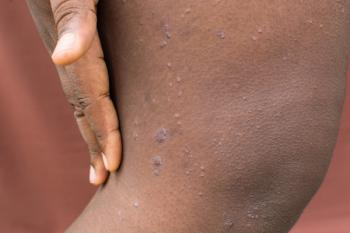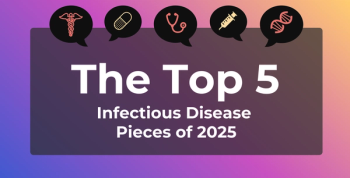
Optimal Therapies for Treating Vitiligo
A variety of treatment options for vitiligo are explored by Drs Dunn, Rosmarin, and King.
Episodes in this series

Jeffrey D. Dunn, PharmD, MBA: We’ve talked about topical steroids, topical calcineurin inhibitors, and light therapy. There are some other things that are used, such as systemic immunosuppressants and methotrexate, which is used in rheumatoid arthritis and other immuno-driven disease states. There are also things like minocycline and vitamin D.
Dr Rosmarin, I’ll start with you and then Dr King. Can you summarize the different treatment options? This is a big, loaded question. Maybe [go over] the pros and cons. Is there consideration given to route of administration? Do you look at patient out-of-pocket cost? Does that influence your decision? Where do we go with some of these other therapies we haven’t talked about yet?
David Rosmarin, MD: Great question. I always like to say that the best stability is availability. I get that from football, where they say that for teams, but it’s also true in medicine. A treatment is no good if a patient can’t get access to it. There are many patients who are willing to pay a very high out-of-pocket cost if it will help get them better or give them a better chance at that outcome. When we divide our treatment goals, the first case is, what if the patient is progressing? Then the standard treatment we give is oral corticosteroids. That’s the most common treatment. Some may try methotrexate or oral minocycline. There are a lot fewer data for that, but the most common choice is oral corticosteroids followed by phototherapy. That doesn’t help patients repigment, but it stops progression. We usually give that a trial over about 12 weeks.
For the next stage, in terms of the repigmentation, I wish I could tell you that there’s a set algorithm. Most people will use some combination of topical corticosteroids, topical calcineurin inhibitors, and phototherapy, either alone or in combination, but there are some other treatments that some providers will recommend, including antioxidants. Some will check vitamin D levels. Some will recommend supplements, such as ginkgo biloba. However, the data for some of these aren’t quite as good as for the first 3 main treatments that I mentioned. Those other ones are less commonly used. Most people feel that the antioxidants will do no harm, and they’re certainly pretty affordable.
In terms of treatments like monobenzone for depigmentation, we usually use that as a later line if we can’t repigment patients or if a patient is mostly depigmented already and only has a few spots of pigment left on the hands, which we know are hard to repigment. They may say they’d rather be completely depigmented than try the almost impossible, which is to get all the pigment back on the hand.
Jeffrey D. Dunn, PharmD, MBA: That actually led into a question I wanted to ask later, but I’m going to ask it now. Are there different considerations or expectations of treatment, or even decisions to treat, based on different parts of the body? We’ve talked about the face and hands. How does that play a role in the patient conversation?
David Rosmarin, MD: Absolutely, 100%. When we see a patient who has facial vitiligo, we have a lot more confidence that we can get their pigment back. When it’s on the tip of the fingers, we have to have a very honest conversation that it’s highly unlikely we’re going to be able to get the pigment back. The hands and acral surfaces are much more challenging. If patients have white hair, or leukotrichia, over their areas of vitiligo, that also portends a poor prognosis.
It’s important that we have that conversation with patients. We want to make sure we aren’t giving patients extra work to do in putting on creams or going through phototherapy for the tips of their fingers if it isn’t realistic or if we’re never going to be able to meet their goals. Certainly, there’s a lot of cost involved as well. Anatomic location is extremely important, along with having a conversation with patients and choosing the appropriate therapy.
Jeffrey D. Dunn, PharmD, MBA: I don’t know how to ask this other than just asking it, because I know there’s interpatient variability and a number of things, but how long would it take to expect repigmentation on the face?
Brett King, MD, PhD: This is where we want concrete [answers]. As much as any of this conversation can be anchored in high-quality data, that’s where we want to be. Because of recent clinical trials of ruxolitinib 1.5% cream for the treatment of vitiligo, we now have great data that say that this is a months-long process and that a significant proportion of patients are going to achieve success over 6 months, but we can nearly double that number with another 6 months of treatment out to a year. It’s important for this conversation and in particular for the listeners who are going to tune in to this conversation. This isn’t a 4-week process. This isn’t a 12-week process. You can’t make a decision about progress over 12 or 16 weeks. This is a months-long process. It’s paramount that listeners hear that.
Now I’m thinking about myself as a provider and thinking about my patients. If somebody comes back to me and says, “Treatment X is approved. I want to see progress in 3 months,” you just asked for the impossible. It doesn’t exist. I’m so glad you asked that question. This is a months-long process. There may be ways to speed it up, as David commented. If we add topical therapy and phototherapy, we can often turn what takes 6 months into a 3-month process. But that’s truly layers of complexity. Is there access to phototherapy? Can the patient get out of work, as David mentioned, for phototherapy? It’s super important to know that this is a months-long process.
Transcript edited for clarity.
Newsletter
Stay ahead of policy, cost, and value—subscribe to AJMC for expert insights at the intersection of clinical care and health economics.









































